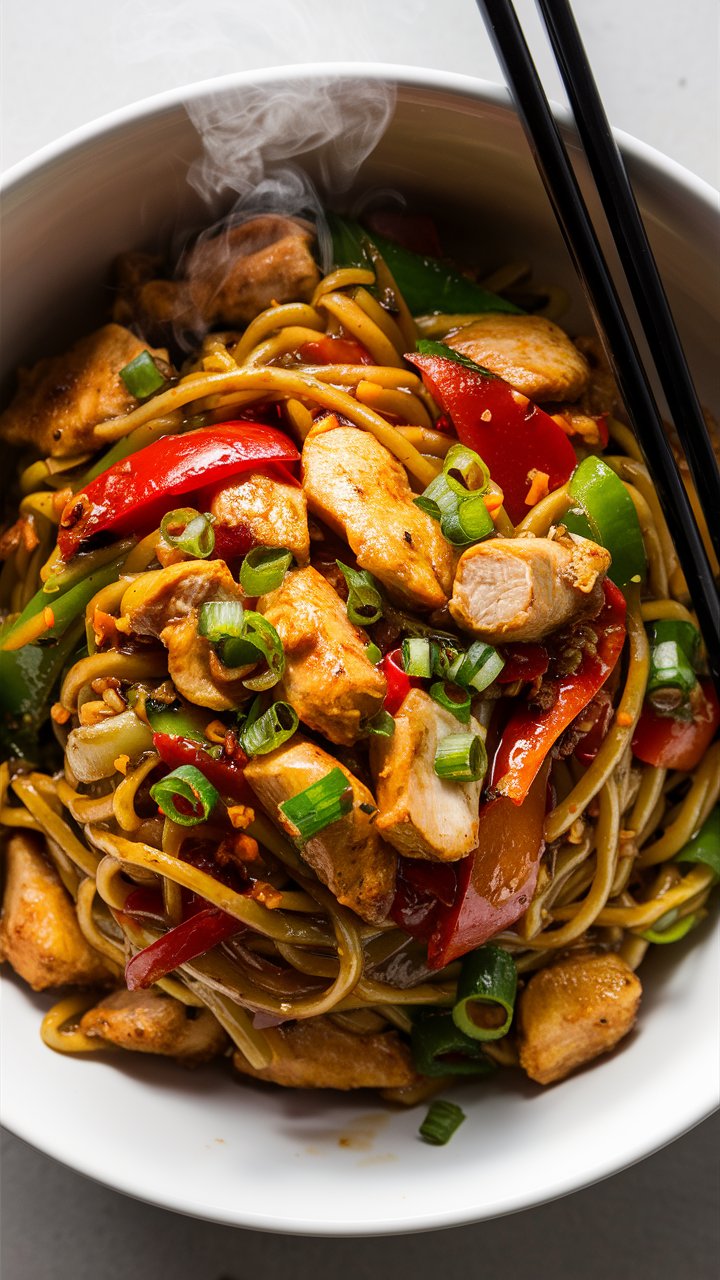
Homemade Chicken Chow Mein with Vegetables in 30 Minutes 2025
When it comes to comfort food that’s fast, flavorful, and satisfying, nothing hits the mark quite like Chicken Chow Mein with Vegetables. This classic stir-fry dish combines tender chicken, chewy noodles, and crisp vegetables, all coated in a glossy, savory sauce that tastes better than takeout. Whether you’re cooking for a busy weeknight dinner or a family gathering, this recipe delivers both flavor and nutrition in a single pan.
In this comprehensive guide, you’ll learn everything from ingredient selection and sauce preparation to cooking techniques, tips for perfect noodles, and creative variations. By the end, you’ll have a go-to recipe that rivals any restaurant version—fresh, customizable, and ready in under 30 minutes.
Why You’ll Love This Chicken Chow Mein Recipe
This recipe isn’t just about convenience—it’s about quality, taste, and versatility. Here’s what makes it stand out:
- Better than takeout: Fresh ingredients, no mystery oils, and no preservatives.
- Quick and easy: From prep to plate in under 30 minutes.
- One-pan meal: Everything cooks in a single wok or skillet, reducing cleanup.
- Customizable: Swap proteins or vegetables based on your preferences.
- Family-friendly: Even picky eaters love saucy, noodle-based dishes.
- Balanced nutrition: Lean protein, fiber-rich veggies, and a flavorful sauce that doesn’t overpower.
Ingredient Highlights
For the Chow Mein Sauce
The sauce is the heart of this dish—it combines sweet, salty, tangy, and umami flavors for a balanced, restaurant-style taste.
- Soy sauce: The umami foundation; opt for low-sodium for better control.
- Oyster sauce: Adds depth and a savory richness.
- Hoisin sauce: Brings a hint of sweetness and complexity.
- Rice vinegar + brown sugar: Balances the flavors with tang and caramelized notes.
- Sesame oil: For a nutty aroma that enhances the dish.
- Cornstarch: Thickens the sauce so it clings perfectly to noodles.
- Chicken broth: Adds body without heaviness.
For the Chicken Chow Mein
- Chow mein noodles: Springy and authentic; spaghetti works in a pinch.
- Chicken breast or thigh: Lean, tender, and quick-cooking.
- Garlic & ginger: Aromatics that elevate the dish.
- Vegetables: Onion, bell pepper, carrot, cabbage for color, crunch, and nutrition.
- Bean sprouts: Add freshness and lightness at the end.
- Green onions & sesame seeds: For garnish and the final touch.
Pro Tips Before You Start
- Slice chicken thinly: Ensures even and quick cooking.
- Prep all ingredients first: Stir-fries move fast, so have everything ready.
- High heat is key: A hot wok or skillet gives the chicken and vegetables a perfect sear.
- Gentle tossing: Toss noodles carefully to prevent breakage.
- Taste as you go: Adjust seasoning to balance sweet, salty, and savory flavors.
Step-by-Step Instructions: How to Make Chicken Chow Mein
Step 1: Prepare the Sauce
In a small bowl, whisk together:
- ¼ cup soy sauce
- 2 tablespoons oyster sauce
- 1 tablespoon hoisin sauce
- 1 tablespoon rice vinegar
- 1 teaspoon brown sugar
- 1 teaspoon sesame oil
- 1 teaspoon cornstarch
- ½ cup chicken broth
Set aside while preparing the noodles and chicken.
Step 2: Cook the Noodles
- Bring a pot of water to boil and cook chow mein noodles according to package instructions until just tender.
- Drain and rinse with cold water to prevent sticking.
- Toss with a teaspoon of oil if not using immediately.
Step 3: Cook the Chicken
- Heat 1 tablespoon vegetable oil in a large skillet or wok over medium-high heat.
- Add the thinly sliced chicken and stir-fry for 5–6 minutes until golden brown and cooked through.
- Remove from skillet and set aside.
Step 4: Stir-Fry the Vegetables
- In the same skillet, heat another tablespoon of oil.
- Add minced garlic and ginger; sauté for 30 seconds until aromatic.
- Add onion, red bell pepper, carrot, and cabbage. Stir-fry 3–4 minutes until crisp-tender.
- For extra flavor, season lightly with a pinch of salt.
Step 5: Combine Chicken, Noodles, and Vegetables
- Return cooked chicken to the skillet.
- Add cooked noodles and bean sprouts.
- Toss gently to combine, ensuring even distribution.
Step 6: Add the Sauce
- Pour the prepared sauce over the noodles.
- Stir-fry for 2–3 minutes until noodles are fully coated and the sauce thickens.
- Taste and adjust seasoning if needed.
Step 7: Garnish and Serve
- Sprinkle chopped green onions and sesame seeds on top.
- Serve immediately while hot for best flavor and texture.
Serving Suggestions
Chicken Chow Mein pairs beautifully with a variety of sides:
- Soups: Egg drop soup, hot and sour soup, or miso soup.
- Appetizers: Spring rolls, potstickers, or dumplings.
- Salads: Asian cucumber salad or seaweed salad for freshness.
- Beverages: Thai iced tea, jasmine milk tea, or a light sparkling drink.
Variations and Substitutions
Protein Swaps
- Shrimp: Cooks quickly and adds a delicate seafood flavor.
- Beef or pork: Thinly sliced for stir-frying.
- Tofu or tempeh: Great for vegetarians.
Vegetable Variations
- Add mushrooms, snow peas, broccoli, or zucchini.
- For color, toss in red cabbage or baby corn.
Noodle Options
- Udon, ramen, or rice noodles can be substituted based on preference.
- For gluten-free options, use rice noodles and tamari in place of soy sauce.
Spice Adjustments
- Add chili paste, Sriracha, or crushed red pepper flakes for heat.
- Drizzle a small amount of sesame oil after cooking for a smoky aroma.
Storage and Leftovers
- Fridge: Store in an airtight container for up to 4 days.
- Reheating: Warm in a skillet or microwave with a splash of water to prevent dryness.
- Freezing: Not ideal for noodles as texture changes; better to freeze chicken and vegetables separately.
- Meal Prep: Divide into portions with extra vegetables for quick lunches.
Frequently Asked Questions (FAQs)
Can I use spaghetti instead of chow mein noodles?
Yes, spaghetti works well. Cook until al dente, then rinse and toss with oil to prevent sticking.
What’s the best oil for stir-frying?
Vegetable, canola, or avocado oil are best due to high smoke points.
Can I make this dish vegetarian?
Absolutely! Omit chicken and increase vegetables or add tofu, tempeh, or mushrooms.
How do I prevent noodles from sticking?
Rinse immediately after boiling and toss with a little oil. Stir gently during cooking.
Can I double the sauce?
Yes, if you prefer extra-saucy noodles.
Does hoisin sauce contain gluten?
Check the label. Use gluten-free alternatives if needed.
Nutrition Highlights (Approximate per serving)
- Calories: 350–400 kcal
- Protein: 25 g
- Carbohydrates: 45 g
- Fat: 10–12 g
- Fiber: 5 g
- Sodium: Moderate (adjust with low-sodium soy sauce)
Tip: Use low-sodium sauces and increase vegetables to reduce sodium while maintaining flavor.
Common Mistakes to Avoid
- Overcooking noodles: Makes them mushy. Always cook slightly underdone and finish in the wok.
- Crowding the pan: Sauté in batches if needed to maintain high heat and prevent steaming.
- Skipping aromatics: Garlic and ginger elevate flavor; don’t skip them.
- Not thickening the sauce: Cornstarch ensures sauce clings to noodles; mix well before adding.
The History and Popularity of Chow Mein
Chow Mein originates from Chinese cuisine, specifically Cantonese style. The term means “stir-fried noodles.” Over time, it has been adapted worldwide, with each region adding its own twist, whether it’s the American-Chinese version with crispy noodles or the classic soft noodles with vegetables and protein. Making it at home ensures authentic taste with fresher, healthier ingredients, far superior to processed takeout options.
Final Thoughts
This Chicken Chow Mein with Vegetables is more than just a quick meal—it’s a complete experience of flavor, texture, and freshness. By preparing it at home, you control the ingredients, portion sizes, and spice levels, making it a healthier and more satisfying alternative to takeout.
From tender chicken and colorful vegetables to springy noodles coated in a savory, slightly sweet sauce, every bite delivers the perfect balance. It’s ideal for weeknight dinners, meal prep, or entertaining family and friends.
Don’t forget to experiment with proteins, vegetables, and sauces to create your signature version. Once you master this recipe, it will become a staple in your kitchen, satisfying cravings and impressing anyone lucky enough to taste it.

